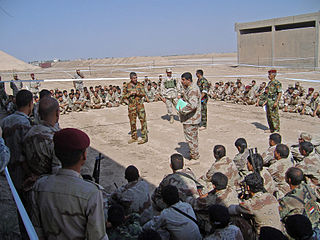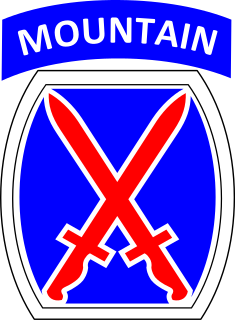
The 101st Airborne Division is a light infantry division of the United States Army specializing in air assault operations. The Screaming Eagles were referred to as "the tip of the spear" by former U.S. Secretary of Defense Robert Gates and the most potent and tactically mobile of the U.S. Army's divisions by former Chief of Staff of the Army GEN Edward C. Meyer. The 101st Airborne can plan, coordinate, and execute multiple battalion-size air assault operations to seize key terrain and can work in austere environments with limited or degraded infrastructure. These operations can be conducted by mobile teams covering large distances and engaging enemy forces behind enemy lines. Its unique battlefield mobility and high level of training have kept it in the vanguard of U.S. land combat forces in recent conflicts, e.g. foreign internal defense and counterterrorism operations in Iraq and Afghanistan.

The 82nd Airborne Division is an airborne infantry division of the United States Army, specializing in parachute assault operations into denied areas with a U.S. Department of Defense requirement to "respond to crisis contingencies anywhere in the world within 18 hours". Based at Fort Bragg, North Carolina, the 82nd Airborne Division is part of the XVIII Airborne Corps. The 82nd Airborne Division is the U.S. Army's most strategically mobile division. More recently, the 82nd Airborne has been conducting operations in Iraq, advising and assisting Iraqi Security Forces.

The 2nd Infantry Division is a formation of the United States Army. Its current primary mission is the pre-emptive defense of South Korea in the event of an invasion from North Korea. There are approximately 17,000 soldiers in the 2nd Infantry Division, with 10,000 of them stationed in South Korea, accounting for about 35% of the United States Forces Korea personnel.

The 36th Infantry Division ("Arrowhead"), also known as the "Panther Division", "Lone Star Division", "The Texas Army", or the "T-patchers", is an infantry division of the United States Army and part of the Texas Army National Guard. It was organized during World War I from units of the Texas and Oklahoma National Guard. It was reactivated for service for World War II 25 November 1940, was sent to the European Theater of Operations in April 1943, and returned to the Texas Army National Guard in December 1945.

The 1st Infantry Division is a combined arms division of the United States Army, and is the oldest continuously serving division in the Regular Army. It has seen continuous service since its organization in 1917 during World War I. It was officially nicknamed "The Big Red One" after its shoulder patch and is also nicknamed "The Fighting First." The division has also received troop monikers of "The Big Dead One" and "The Bloody First" as puns on the respective officially sanctioned nicknames. It is currently based at Fort Riley, Kansas.

The 4th Infantry Division is a division of the United States Army based at Fort Carson, Colorado. It is composed of a division headquarters battalion, three brigade combat teams, a combat aviation brigade, a division sustainment brigade, and a division artillery.

The 1st Cavalry Division is a combined arms division and is one of the most decorated combat divisions of the United States Army. It is based at Fort Hood, Texas. It was formed in 1921 and served during World War II, the Korean War, the Vietnam War, the Persian Gulf War, with the Stabilization Force in Bosnia-Herzegovina, in the Iraq War, in the War in Afghanistan and in Operation Freedom's Sentinel. As of October 2017, the 1st Cavalry Division is subordinate to III Corps and is commanded by Major General John B. Richardson.

The 10th Mountain Division is a light infantry division in the United States Army based at Fort Drum, New York. Designated as a mountain warfare unit, the division is the only one of its size in the US military to receive intense specialized training for fighting in mountainous and arctic conditions. More recently, the 10th Mountain has been conducting operations in Iraq, advising and assisting Iraqi Security Forces.

The 25th Infantry Division is a United States Army division based at Schofield Barracks in Hawaii. The division, which was activated on 1 October 1941 in Hawaii, conducts military operations primarily in the Asia-Pacific region. Its present deployment is composed of Stryker, light infantry, airborne, and aviation units. Tropic Lightning soldiers serve as the premier Army response force for the U.S. Pacific Command, and regularly train with other U.S. military branches to practice and maintain joint operations capabilities. The climate and terrain of the Pacific region demands Tropic Lightning soldiers be able to operate in physically demanding and harsh environments. In 2014, the division opened the Jungle Operations Training Center—the first such school in the Army since the closing of the old Jungle Warfare School at Fort Sherman, Panama Canal Zone. Joint operations and training with partner states herald a new chapter in the history of Tropic Lightning—America's Pacific Division.

The 77th Sustainment Brigade is a unit of the United States Army that inherited the lineage of the 77th Infantry Division, which served in World War I and World War II. Its headquarters has been at Fort Dix, New Jersey, since its predecessor command, the 77th Regional Readiness Command, was disestablished in 2008 from Fort Totten, in Bayside (Queens), New York. Soldiers from the 77th have served in most major conflict and contingency operations since World War II.

The 28th Infantry Division ("Keystone") is a unit of the Army National Guard and is the oldest division-sized unit in the Department of Defense. Some of the units of the division can trace their lineage to Benjamin Franklin's battalion, The Pennsylvania Associators (1747–1777). The division was officially established in 1879 and was later redesignated as the 28th Division in 1917, after the entry of America into the First World War. It is today part of the Pennsylvania Army National Guard, Maryland Army National Guard, Ohio Army National Guard, and New Jersey Army National Guard.

The 325th Infantry Regiment is a light infantry parachute insertion fighting force of the United States Army. The subordinate units of the regiment constitute the bulk of the infantry elements assigned to the 2nd Infantry Brigade Combat Team, 82nd Airborne Division.
The United States Army Regimental System (USARS) was established in 1981 to replace the Combat Arms Regimental System (CARS) to provide each soldier with continuous identification with a single regiment, and to increase a soldier's probability of serving recurring assignments with his or her regiment. The USARS was intended to enhance combat effectiveness by providing the opportunity for a regimental affiliation, thus obtaining some of the benefits of the traditional regimental system.
Operation River Falcon was a military operation in the Iraq War. From 25–27 July 2006, elements of the United States Army 2nd Brigade Combat Team, 4th Infantry Division conducted Operation River Falcon in and around the town of Sayifiyeh in Iraq. The operation was aimed at denying terrorists the use of the town as a safe haven, disrupting insurgent attacks on Coalition and Iraqi Army/Police, and on collecting and destroying insurgent munitions.
The Battle of Baqubah II took place during the Iraq War in the capital of the Iraqi province Diyala, to the north-east of Baghdad. It began in early March 2007, when US and Iraqi forces commenced preliminary operations to "establish a presence in Diyala beyond their Forward Operating Base".

Operation Commando Eagle was a 2007 military operation of the Iraq War. It began on 21 June 2007, when Iraqi and Coalition forces launched a combined ground and air assault operation against al-Qaeda and other extremist terrorists operating in the Mahmudiyah region of Babil province. The action was intended to curb terrorist activity southwest of Baghdad through a mix of helicopter assaults and Humvee-mounted movements.
A midnight mission by combined U.S. and Iraqi army forces resulted in 12 men being detained for questioning on suspicion of terrorist activity.

Operation Phantom Strike was a major offensive launched by the Multi-National Corps - Iraq on 15 August 2007 in a crackdown to disrupt both the al-Qaeda-affiliated Islamic State of Iraq and Shia insurgent operations in Iraq. It consisted of a number of simultaneous operations throughout Iraq focused on pursuing remaining ISI terrorists and Iranian-supported insurgent groups. It was concluded in January 2008 and followed up with Operation Phantom Phoenix.

The 27th Infantry Brigade Combat Team ("Empire") is an infantry brigade combat team of the New York Army National Guard, one of the brigades that make up the 42nd Infantry Division.

The 1st Brigade Combat Team, 10th Mountain Division is an active Infantry Brigade Combat Team of the United States Army based at Fort Drum in New York. The brigade headquarters carries the lineage of the 10th Mountain Division's original headquarters company, and served as such in World War II, and in peacetime at Fort Riley, Fort Benning, and West Germany in the 1940s and 1950s.















